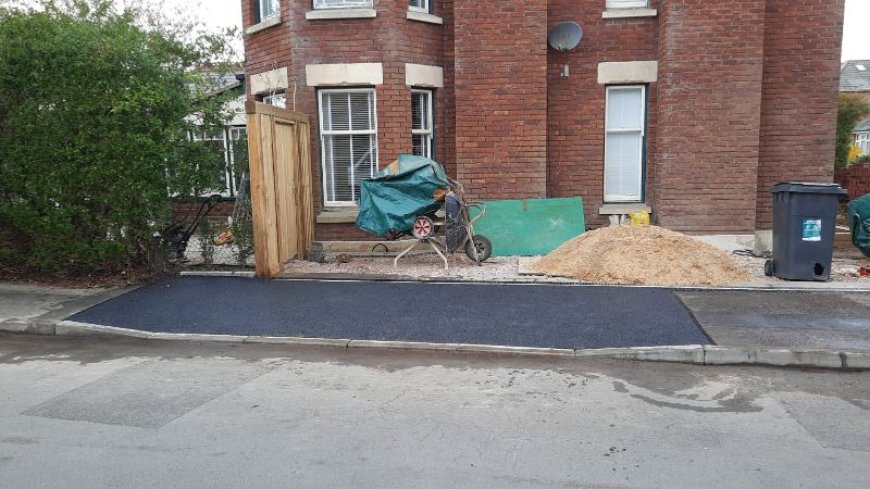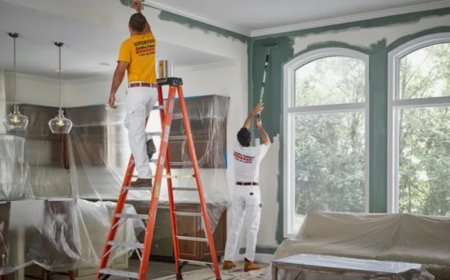Asphalt Driveway Repair: A Comprehensive Guide for Homeowners
In this guide, we will explore common driveway issues, methods of repair, and tips to keep your asphalt driveway in top shape.

An asphalt driveway is a durable and aesthetically pleasing addition to any home. However, over time, exposure to the elements, heavy traffic, and general wear and tear can cause cracks, potholes, and fading. Asphalt driveway repair is essential to maintain the longevity, safety, and curb appeal of your driveway. In this guide, we will explore common driveway issues, methods of repair, and tips to keep your asphalt driveway in top shape.
Common Asphalt Driveway Problems
Before diving into the repair process, its important to understand the most common issues that can arise with asphalt driveways. Recognizing these problems early can prevent further damage and costly repairs.
1. Cracks
Cracks are one of the most common problems homeowners face with asphalt driveways. They can occur due to temperature fluctuations, moisture infiltration, and the natural settling of the ground beneath the driveway. Cracks can range from small hairline fractures to large fissures that require more extensive repairs.
2. Potholes
Potholes are larger, deeper depressions in the asphalt caused by the combination of water infiltration, freeze-thaw cycles, and constant vehicle traffic. If not repaired promptly, potholes can grow larger, leading to even more severe damage and posing a safety hazard for drivers and pedestrians.
3. Surface Wear and Fading
Asphalt driveways naturally fade over time due to exposure to UV rays, moisture, and physical stress. The dark black color of the asphalt gradually fades, leaving the driveway looking dull and worn. This surface wear can also cause the driveway to become porous, which leads to further damage.
4. Drainage Issues
Improper drainage is another major concern for asphalt driveways. If the driveway does not slope adequately to allow water to run off, it can pool in certain areas. This stagnant water can seep into the asphalt, weakening the structure and leading to cracking and potholes.
5. Alligator Cracking
Alligator cracking appears as a pattern of small interconnected cracks that resemble the scales of an alligator. This type of damage is usually a result of underlying issues, such as a weak or improperly compacted base, heavy traffic, or poor-quality asphalt.
The Importance of Timely Asphalt Driveway Repair
Timely asphalt driveway repair is crucial for several reasons. If left unchecked, even minor damage can worsen and become more expensive to fix. Regular maintenance helps preserve the structural integrity of the driveway, improving its overall performance and safety. Additionally, repairing issues like cracks and potholes prevents water from seeping into the sub-base, which can lead to bigger problems down the road.
A well-maintained asphalt driveway also enhances the curb appeal of your home. If youre planning to sell your property, a smooth, well-kept driveway can increase the homes value and create a positive first impression for potential buyers.
Asphalt Driveway Repair Methods
There are various ways to repair an asphalt driveway, depending on the extent of the damage. Below are some of the most common asphalt repair methods:
1. Crack Sealing
For smaller cracks (less than half an inch wide), crack sealing is an effective and affordable repair method. This involves cleaning the crack, applying a sealant, and smoothing it over to create a seamless surface. Crack sealing prevents water from entering the cracks and causing further damage.
2. Pothole Repair
Repairing potholes typically involves removing the damaged asphalt, filling the hole with new asphalt or cold patch material, and compacting the surface. For larger potholes, it may be necessary to repair the underlying base layer to ensure the new asphalt adheres properly and lasts longer.
3. Resurfacing
If the surface of the driveway is severely worn, resurfacing may be a good option. This involves adding a new layer of asphalt over the existing driveway to restore its appearance and functionality. Resurfacing is often a more cost-effective solution than completely replacing the driveway.
4. Sealcoating
Sealcoating is an essential maintenance step that helps protect your asphalt driveway from the elements. A thin layer of sealant is applied to the surface to prevent water penetration, UV damage, and oil stains. Sealcoating also gives the driveway a fresh, black appearance and extends its lifespan.
5. Full Driveway Replacement
In cases where the asphalt driveway is beyond repair due to significant damage, a full driveway replacement may be necessary. This is a more expensive option, but it ensures a completely new surface that will last for years to come.
Step-by-Step Guide to Asphalt Driveway Repair
Repairing an asphalt driveway is a straightforward process, provided you have the right tools and materials. Heres a step-by-step guide to help you repair minor damage yourself.
Step 1: Clean the Surface
Before you start any repair work, its essential to clean the surface thoroughly. Sweep away any dirt, debris, and leaves. If there are oil stains, use a degreaser to remove them. For cracks or potholes, use a wire brush or scraper to clean the damaged areas and remove any loose debris.
Step 2: Repair Cracks
For smaller cracks, use a crack filler or asphalt crack sealant. Pour the crack filler directly into the crack and smooth it out with a putty knife or trowel. Be sure to follow the manufacturers instructions and allow the filler to dry completely before moving on to the next step.
Step 3: Repair Potholes
To repair potholes, start by removing any loose or damaged asphalt around the pothole. Use a shovel or a trowel to clear the area. Then, fill the hole with a cold patch or fresh asphalt, ensuring that its level with the surrounding surface. Compact the material with a tamper to make sure it is secure. You may need to apply multiple layers of material and compact them individually to achieve a smooth, level surface.
Step 4: Resurfacing (Optional)
If your driveway has extensive surface damage, you may consider resurfacing. To do this, spread a thin layer of fresh asphalt over the existing driveway. Use a rake or squeegee to spread it evenly, and then compact the surface with a roller to ensure proper adhesion.
Step 5: Sealcoat the Surface
After repairing the cracks and potholes, its time to sealcoat the surface. Use a long-handled brush or roller to apply a thin layer of sealant over the entire driveway. Work in small sections to avoid uneven coverage, and allow the sealant to dry for at least 24-48 hours before using the driveway.
Tips for Long-Lasting Asphalt Driveway Maintenance
Preventing damage is just as important as repairing it. Here are some tips to extend the lifespan of your asphalt driveway:
1. Regular Cleaning
Keeping your driveway clean is essential for maintaining its condition. Remove dirt, leaves, and debris regularly to prevent them from causing damage to the surface. Power washing can also help remove stubborn stains and dirt.
2. Sealcoat Every Few Years
Sealcoating your asphalt driveway every 2-3 years helps protect it from the elements and enhances its appearance. It forms a protective barrier against water, UV rays, and chemicals like oil and gasoline.
3. Fix Problems Early
Address small cracks and potholes as soon as they appear to prevent them from getting worse. The sooner you repair damage, the less expensive and time-consuming the repairs will be.
4. Proper Drainage
Ensure that your driveway has proper drainage to prevent water from pooling in low spots. Regularly check the slope of your driveway and make adjustments if necessary to ensure proper water runoff.
5. Avoid Heavy Loads
Avoid parking heavy vehicles or machinery on your driveway for extended periods, as this can cause cracks and depressions. If you have to park heavy vehicles, try to spread the weight evenly across the surface.
Conclusion
Asphalt driveway repair is an essential part of homeownership, as it helps maintain the safety, functionality, and curb appeal of your property. Regular maintenance, including crack sealing, pothole repair, resurfacing, and sealcoating, can significantly extend the lifespan of your driveway. By addressing issues early and following proper maintenance practices, you can keep your asphalt driveway in top condition for years to come.
If the damage to your driveway is too severe, dont hesitate to consult a professional for assistance. With the right care and attention, your asphalt driveway will continue to provide a smooth, durable, and attractive surface for years to come.




































